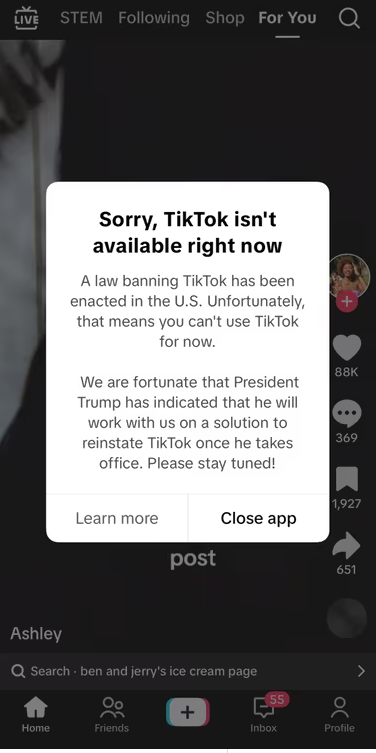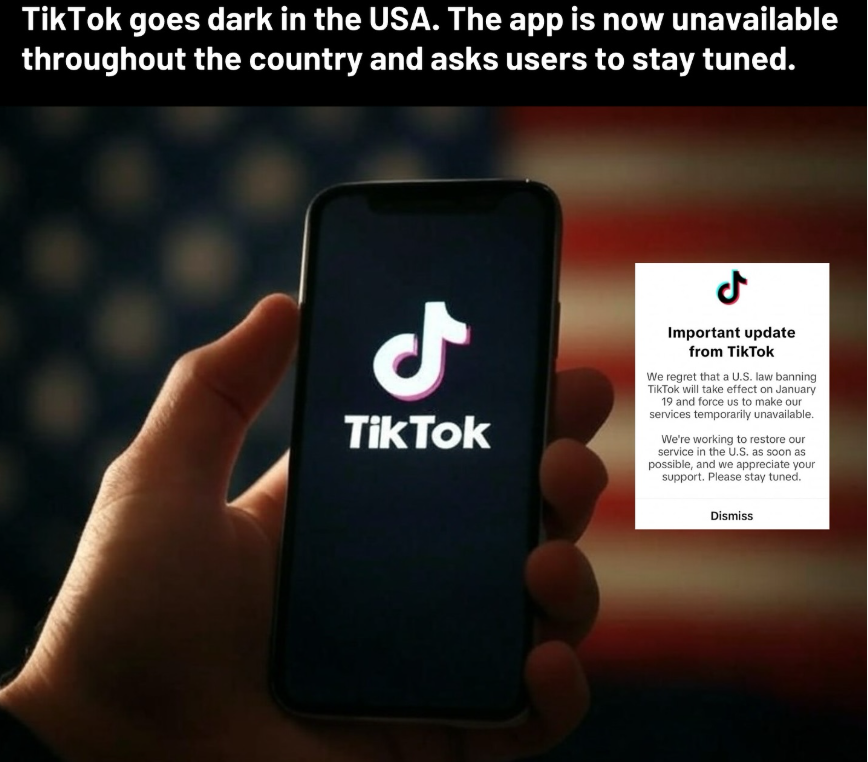
TikTok has officially ceased operations in the U.S. as of late Saturday, just ahead of a federal ban that was set to take effect. The app was removed from both Apple’s iOS App Store and Google’s Play Store, marking a significant step in the ongoing conflict between TikTok and the U.S. government.
The ban was enforced after U.S. Congress passed the Protecting Americans from Foreign Adversary Controlled Applications Act in April, mandating that TikTok’s parent company, ByteDance, either sell the app to a non-Chinese owner or face a complete shutdown. The company stood firm in its decision not to sell, citing numerous legal, technological, and commercial barriers.

TikTok’s lawyer argued before the U.S. Supreme Court that the app would “go dark” on January 19, and once removed from the stores, it would eventually become obsolete. Without regular updates, glitches could worsen, and the app could become vulnerable to cyber-attacks.
The ban started in 2020, when Donald Trump first proposed banning TikTok via executive order, a move that failed. Subsequent attempts by U.S. lawmakers also fizzled, but eventually, this latest law was passed and upheld. Despite TikTok’s legal battles, the Supreme Court ruled on January 17 that the ban was constitutional.
This law mandates that TikTok must either be sold or removed, and TikTok has fought this action all the way, arguing it infringed on free speech. But in the end, their case was rejected, with the Supreme Court’s ruling leaving the law intact.
A Possible Lifeline? Trump’s Potential Reprieve
In a twist, Donald Trump—who initially supported the TikTok ban—has now become an unlikely advocate for the app. As he prepares to take office again, Trump has indicated that he may grant TikTok a 90-day reprieve, allowing for further negotiations or alternative solutions.
He hinted at this during an NBC interview on January 13, suggesting that a delay might be “appropriate” as he works with TikTok on a solution to keep it in the U.S. Whether this will hold up after he’s inaugurated is still uncertain, but Trump’s support for TikTok has definitely shaken up the narrative.
A Surge of Users to Xiaohongshu
While TikTok is disappearing from U.S. app stores, many TikTok users are migrating to other platforms. Interestingly, the main alternative is not YouTube Shorts or Instagram Reels—the usual competitors to TikTok—but rather the Chinese app Xiaohongshu (Little Red Book).
Xiaohongshu, known for its blend of lifestyle content, shopping guides, and personal stories, has seen a significant increase in U.S. users since the TikTok ban was imminent.
One TikTok user put it bluntly: “I’d drop-ship my DNA to the front door of the Chinese Communist Party before I watch an Instagram Reel.”
The sudden migration to Xiaohongshu highlights a unique digital shift as users try to find a new space that mirrors the short-video format TikTok is known for.
The Future of TikTok in the U.S.
As of now, TikTok’s future in the U.S. is uncertain. The app may continue to exist for a short time through its current user base, but without new downloads and updates, it risks becoming a shadow of its former self. Whether Trump’s possible 90-day reprieve will ultimately save TikTok, or if the app’s competitors like Xiaohongshu will fill the void, remains to be seen.
For now, it’s clear that this battle over TikTok has far from reached its conclusion.






